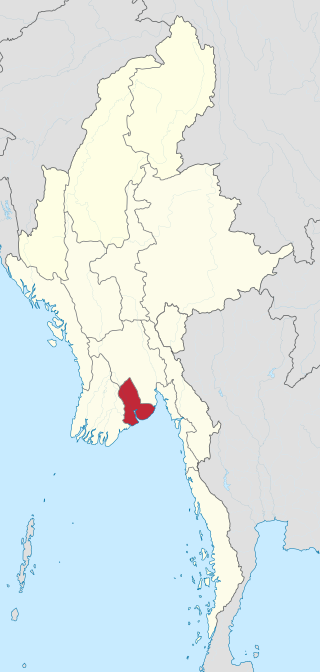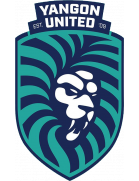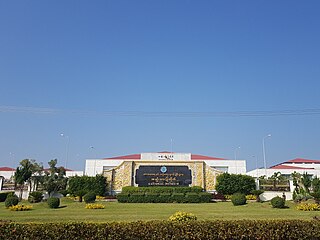
Yangon, formerly romanized as Rangoon, is the capital of the Yangon Region and the largest city of Myanmar. Yangon served as the capital of Myanmar until 2006, when the military government relocated the administrative functions to the purpose-built capital city of Naypyidaw in north central Myanmar. With over five million people, Yangon is Myanmar's most populous city and its most important commercial centre.

Bago, formerly known as Hanthawaddy, is a city and the capital of the Bago Region in Myanmar. It is located 91 kilometres (57 mi) north-east of Yangon.

Yangon Region is an administrative region of Myanmar. Located in central Myanmar, the region is bordered by Bago Region to the north and east, the Gulf of Martaban to the south, and Ayeyarwady Region to the west. Yangon Region is dominated by its capital city of Yangon, the former national capital and the largest city in the country. Other important cities are Thanlyin and Twante. The division is the most developed region of the country and the main international gateway. The division measures 10,170 km2 (3,930 sq mi).

Naypyidaw, officially romanized Nay Pyi Taw, is the capital and third-largest city of Myanmar. The city is located at the centre of the Naypyidaw Union Territory. It is unusual among Myanmar's cities, as it is an entirely planned city outside of any state or region. The city, then known only as Pyinmana District, officially replaced Yangon as the administrative capital of Myanmar on 6 November 2005; its official name was revealed to the public on Armed Forces Day, 27 March 2006.

Yangon International Airport is the primary and busiest international airport of Myanmar. The airport is located in Mingaladon, 15 kilometres (9.3 mi) north of central Yangon. All ten Myanmar carriers and about 30 international airlines operate at Yangon International Airport. The airport is also colloquially known as Mingaladon Airport due to its location.
Insein Township is located in northern Yangon. The township comprises 21 wards, and shares borders with Shwepyitha township in the north, Hlaingthaya township in the west, Mingaladon township in the east and Mayangon township in the south. Insein is home to the Insein Prison, the most notorious prison in the country that houses hundreds of political prisoners. Until the 1990s, Insein, about 20 miles (32 km) from central Yangon, was beyond Yangon's city limits although by the 1980s, Insein was already integrated with the rest of the city. With the expansion of Yangon's city limits in the 1990s which also included founding new satellite towns, Insein was formally incorporated into Yangon.

The Yangon General Hospital is a major public hospital in a 14-hectare (35-acre) compound in Yangon, Myanmar. The 2,000-bed hospital consists of seven medical wards, three surgical wards, two trauma and orthopaedic wards, and 28 specialist departments for inpatient care. The hospital also runs an ER for general medicine, general surgery and traumatology.

The National Museum of Myanmar (Yangon), (Burmese: အမျိုးသား ပြတိုက်), located in Dagon, Yangon, is the major one of the two national museums for Burmese art, history and culture in Myanmar. Founded in 1952, the five-storey museum has an extensive collection of ancient artifacts, ornaments, work of art, inscriptions and historic memorabilia, related to history, culture and civilization of Burmese people. The main attraction of the museum is the only surviving original Lion Throne of the Burmese monarchs. There are more than 4000 permanent objects in the museum.

The Bogyoke Aung San Museum, located in Bahan, Yangon, is a museum dedicated to General Aung San, the founder of modern Myanmar (Burma). Established in 1962, the two-story museum was Aung San's last residence before his assassination in July 1947. It is a colonial-era villa, built in 1921, where his daughter Aung San Suu Kyi grew up as a child. The museum, with its focus on Gen. Aung San's short adult life, is complementary to the Bogyoke Aung San Residence Museum in Natmauk, Magwe Division, which is dedicated to his childhood and family memorabilia. It houses exhibits on his life story and general memorabilia which includes clothing, books, furniture, family photos and the late general's car.

Dagon Township is located immediately north of downtown Yangon. The township comprises five wards, and shares borders with Bahan Township in the north, Ahlon Township in the west, Mingala Taungnyunt Township in the east, and Lanmadaw Township, Latha Township and Pabedan Township in the south.
The Drug Elimination Museum is a museum in Yangon, Myanmar. It opened with ceremony on June 26, 2001. It is located at the corner of Kyandaw Road and Hanthawady Road in Kamayut Township, Yangon, Burma, on the former site of the city's largest cemetery, Kyandaw Cemetery. It is dedicated to the International Day Against Drug Abuse and illicit trafficking.

The Myanmar National League is the premier national professional football league of Myanmar. In 2009, the league replaced the Myanmar Premier League, which consisted only of 14 Yangon-based football clubs, with eight professional clubs representing different regions across the nation. On 16 May 2009, the league launched its inaugural two-month tournament, the Myanmar National League Cup 2009 in preparation for the first full season in 2010. Despite its national ambitions, the league held the MNL Cup 2009 matches in the country's two main stadiums in Yangon due to the lack of adequate facilities elsewhere. On 5 July 2009, Yadanabon FC defeated Yangon United FC in the MNL Cup final to become the first-ever MNL Champions.

Yangon United Football Club is a Burmese football club, based at Yangon United Sports Complex, in Yangon, Myanmar. Owned by Tay Za, a prominent Burmese businessman, the club was one of eight teams that participated in the inaugural edition of the Myanmar National League in 2009, where they finished as runners-up. The club have won a record of 5 league titles, 3 General Aung San Shield and 3 MFF Charity Cup.

Burmese Gurkhas are a group of Nepali language speaking Burmese people of Khas/Gurkha ethnic group living in Myanmar. While the Gurkhas have lived in Burma for many centuries, it was during the British rule in Burma that the majority of the Gurkha migrated from Nepal.
The 2016 Myanmar National League, also known as the 2016 Ooredoo Myanmar National League, was the 7th season of the Myanmar National League, the top Burmese professional league for association football clubs since its founding in 2009.The transfer period for the 2016 season was from 1 November 2015 to 8 January 2016.

The National Museum of Myanmar (Naypyidaw) (Burmese: အမျိုးသားပြတိုက် (နေပြည်တော်)) is a modern museum located near the Kumudra circle, in Ottarathiri Township, Naypyidaw, Myanmar (Burma). Besides the older National Museum of Myanmar in Yangon, it is the second of the two national museums for Burmese art, history and culture in Myanmar.

The Ministry of Religious Affairs and Culture administers the religious affairs, cultural affairs and historical and archaeology research efforts of Myanmar. The Department of Religious Affairs purification, perpetuation, promotion and propagation of the Theravada Buddhist Sasana and promotes Myanmar traditional customs and culture.